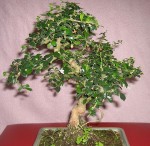 This tropical evergreen shrub is native to southern China and is a good subject for bonsai. The brownish red trunk becomes thick and attractive with age and the small leaves are oval, shiny and dark green. White flowers are produced in early summer and may continue all year if conditions are optimal. Green berries replace the flowers and gradually turn orange, red, and black. Fukien tea is attractive in many styles including informal upright, slanting, cascade, semi-cascade, clasped–to-rock, rock-over root, twin-trunk, and clump. Unfortunately it is not an easy bonsai to maintain and is recommended for the expert. It responds poorly to changes in temperature, drought or over watering. In addition, the light has to be regulated so that the plant receives enough light to produce berries but not so much that the leaves are burned. If insects such as aphids are a problem use insecticidal soap rather than harsh chemical sprays to avoid leaf damage. Yellow or fallen leaves may be the result of over-watering.
This tropical evergreen shrub is native to southern China and is a good subject for bonsai. The brownish red trunk becomes thick and attractive with age and the small leaves are oval, shiny and dark green. White flowers are produced in early summer and may continue all year if conditions are optimal. Green berries replace the flowers and gradually turn orange, red, and black. Fukien tea is attractive in many styles including informal upright, slanting, cascade, semi-cascade, clasped–to-rock, rock-over root, twin-trunk, and clump. Unfortunately it is not an easy bonsai to maintain and is recommended for the expert. It responds poorly to changes in temperature, drought or over watering. In addition, the light has to be regulated so that the plant receives enough light to produce berries but not so much that the leaves are burned. If insects such as aphids are a problem use insecticidal soap rather than harsh chemical sprays to avoid leaf damage. Yellow or fallen leaves may be the result of over-watering.
Position: Indoors, keep in location with bright light and no direct sunlight from noon until 3:00 PM and temperatures between 50o .F and 75o F. In summer it can be taken outdoors and placed in a shady location. When changing the location of Fukien tea from inside to outdoors or the reverse, do so gradually so as not to cause shock from the change in temperature.
Water: Keep evenly moist and do not allow to dry out. Both too little and too much water will cause problems for the plant. A pebble tray is beneficial indoors to provide higher humidty.
Fertilizer: Apply liquid bonsai fertilizer every two weeks from early spring through summer. During the winter feed every six weeks if plant is in warm location. Water well before applying fertilizer to avoid root burn.
Repotting: Repot every two years in the spring, accompanied by moderate root pruning.
Soil: Soil should be very well drained; use a bonsai soil or a mixture of loam, peat moss, and sand in a ration of 2:2:1.
Pruning: Root prune moderately in spring when repotting; Cut back new shoots to two to three leaves when they have developed at least six to eight leaves. Prune branches throughout the year as needed.
Wiring: Shaping is often accomplished without wiring but can be done throughout the year as soon as the stems become woody.
Propagation: Seed; stem cuttings throughout the year with mid spring to early summer being the best time.
